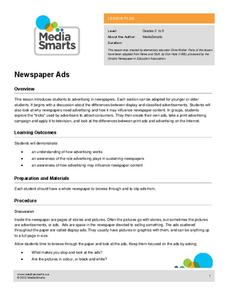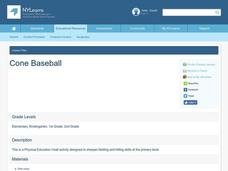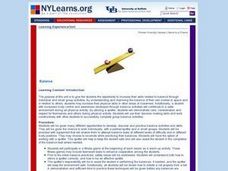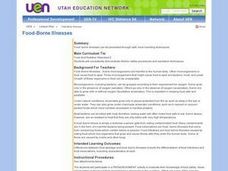Media Smarts
Newspaper Ads
Just how free is the press? After examining the advertising and propaganda techniques used by advertisers, class members consider the influence advertisers may exert over newspaper content.
ARKive
Temperate Rainforest in the Pacific Northwest
Explore the amazing temperate rainforest of the Pacific Northwest. Your class starts by investigating the animals and plants of the Northwest, specifically Washington, and then research an animal population common to the area. In small...
Curated OER
Nutrition Lesson Plan
Third graders explore a variety of breakfast foods and beverages and write a creative story about their favorite. They then present their stories to the class and are encouraged to try different foods during the story time.
Curated OER
The ABC's of Breakfast
Students identify the food group of various culturally diverse breakfast foods and discuss the importance of eating a healthy, well-balanced breakfast every morning. They then try different foods that begin with the letter A, B and C and...
Curated OER
Credit - Good? Bad?
Students examine credit cards. They explore the detrimental effects that result from debt and poor credit. Students analyze interest rates, minimum balances, and consumer debt. Students survey the benefits of credit cards.
Curated OER
Interplanetary Travel Guide
In groups of six, middle school space scientists create an imaginative travel brochure for attracting visitors to the planet Mars. Information must include surface features and atmospheric conditions. Although time-consuming, this is a...
Bridge
Mercury - Mercury is Rising
Hold a discussion in your class about the increase in mercury being found in fish that are caught commercially as food for humans. Given a worksheet, learners then calculate how much fish a person can safely eat each month to remain...
Curated OER
Target Audience
Students explore and describe various persuasive tools used in advertisements, analyze advertisements provided by teacher, and identify target audiences. Students then work in groups to find advertisements aimed at assigned target...
Curated OER
Suicide Prevention
Students are introduced to various concepts related to suicide prevention. They watch a video, read case studies, distinguish between facts and myths about suicide, identify suicide warning signs and participate in class discussion.
Curated OER
Being an Educated Consumer of Statistics
Students examine kinds of data used to report statistics, and create their own statistical report based on any of the four sources of media information (Internet, newspaper, TV, magazine).
Curated OER
Print & Go ESL
Improve reading comprehension with a set of ESL worksheets. Kids read through various passages, note which facts are true or false, mark their opinion on two statements, and write a short reply based on a writing prompt.
Missouri Department of Elementary
Juggling New Opportunities
Life is like trying to juggle three tennis balls! That's the big idea in a lesson that asks freshmen to consider that sometimes juggling the areas of their lives (social/emotion, academic, and career) runs smoothly and sometimes not so...
Curated OER
Cone Baseball
Learners practice fielding and hitting skills. Using different size balls, students play t-ball. They practice hitting the ball where partners are not standing Learners work together to get the batter out.
Curated OER
Puberty
Eighth graders participate in a whole group discussion about their thoughts and feelings surrounding puberty. Students watch a video and view slides in order to describe the bodily changes that occur during adolescence.
Curated OER
Balance Activities
Young scholars, through group and individual activities, study and experiment with the concept of balance. They attempt balancing tasks at different levels of difficulty and in different body positions. They work to improve their balance.
Curated OER
Food-Borne Illnesses
Use this lesson to have your charges consider the differences between food spoilage and food-borne illnesses including the differentiation of food infections and food intoxication, including characteristics of each. Some excellent...
Curated OER
The Female Reproductive System
Students identify the different parts of the female reproductive system. In this health science lesson, students explain the functions of each part. They research Female Reproductive Health Issue and share their findings in class.
Curated OER
Salt, To Use or Not To Use
Fifth graders develop a deeper understanding of chemical and physical changes. They explain how salt is made, used, and the affects it has on the body. They explain that salt in moderation is important to our health.
Curated OER
The Male Reproductive System
Young scholars name the different parts of the male reproductive system. In this health science lesson, students research health issues affecting the male reproductive system. They create a presentation and share it to class.
Curated OER
Wellness Inventory
Eighth graders evaluate their own health status. In this health science lesson, 8th graders complete a worksheet of wellness inventory. They design an improvement plan for themselves.
Curated OER
Carbohydrates, Proteins, and Fats
Young scholars describe the properties of carbohydrates, proteins and fats. In this health science lesson, students identify food sources where these nutrients can be found. They explain how they affect our body.
Curated OER
Puberty
Eighth graders describe the changes their body undergoes during puberty. In this health science lesson plan, 8th graders explain how the hypothalamus and pituitary gland play a major role in the process. They identify the different parts...
Curated OER
Vitamin Planet
Young scholars explain the function of vitamins in their body. In this health lesson, students identify the six types of vitamins. They create a chart comparing two of them.
Curated OER
European Agriculture
Sixth graders explore differences between European agriculture and American agriculture. In this agriculture lesson, 6th graders investigate the role that cultural differences play in agriculture and how these cultural differences affect...

























